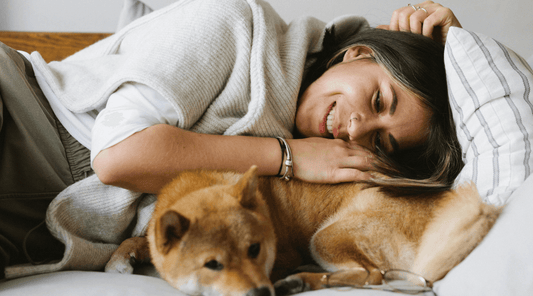
Why Is My Dog Hyper After a Walk?
Rachel RobsonShare
Have you ever returned from a walk with your furry friend, only to find them bouncing off the walls with seemingly endless energy? You're not alone!
Many dog owners experience this puzzling phenomenon of their pup becoming super hyper after what should have been an exhausting outing.
Let's dive into the reasons behind this energetic behaviour and how you can help manage it.
Why Dogs Get Zoomies After Walks
Physiological Excitement
When dogs go on walks, they experience a cocktail of stimulating experiences. New smells, sights, and sounds trigger their natural excitement response. Just like humans get a post-exercise high, dogs release adrenaline and endorphins during physical activity. This biological response can leave them feeling energized and ready to play even after what seems like a tiring walk.
Mental Stimulation Overload
Walks aren't just physical exercise – they're mental adventures for your dog. Every tree, fire hydrant, and passing squirrel is a potential source of excitement. This sensory overload can create a state of heightened arousal that doesn't immediately dissipate once you're home.
Common Reasons for Post-Walk Hyperactivity
- Insufficient Exercise Intensity Not all walks are created equal. If your walk involves lots of stops, slow walking, or minimal active movement, your dog might not have burned enough energy. They could be storing up kinetic energy waiting to be released.
- Breed-Specific Energy Levels Some dog breeds are naturally more energetic than others. Working dogs like Border Collies, Australian Shepherds, and Jack Russell Terriers have historically been bred for high-intensity tasks, making them more prone to post-walk excitement.
- Young Dog Syndrome Puppies and younger dogs typically have more energy to spare. Their bodies are still developing, and they haven't yet learned to regulate their excitement levels as efficiently as older dogs.
Managing Post-Walk Hyperactivity: Practical Tips
1. Structured Play
After your walk, engage your dog in structured play that allows them to release remaining energy in a controlled manner. Use puzzle toys, play fetch, or practice training commands to help them transition from walk mode to calm mode.
2. Create a Calm Environment
Implement a post-walk routine that signals it's time to relax. This might include:
- Giving them a specific resting spot
- Providing a chew toy
- Playing calm background music
- Using gentle petting and soothing words
3. Adjust Walk Dynamics
Consider changing your walking routine:
- Include more active movement like jogging or playing fetch during the walk
- Vary your walking routes to provide mental stimulation
- Use training exercises during walks to engage their mind
4. Consider Professional Training
If hyperactivity persists and becomes challenging, consider working with a professional dog trainer who can provide personalized strategies for your specific dog.
When to Be Concerned
While post-walk hyperactivity is normal, persistent extreme behaviour might indicate:
- Lack of proper exercise
- Potential anxiety
- Underlying health issues
If you're worried about your dog's behaviour, always consult with your veterinarian to rule out any medical concerns.
Conclusion
Understanding why your dog becomes hyper after walks can help you better manage their energy and create a more harmonious home environment.
Remember, every dog is unique, and what works for one might not work for another.
Patience, consistency, and a bit of understanding go a long way in helping your furry friend find their calm.
Pro Tip: Keep a journal of your dog's post-walk behaviour to identify patterns and track the effectiveness of different calming strategies.



